V-rep学习笔记:Geometric Constraint Solver(几何约束求解)
The geometric constraint solver is slower and less precise at solving kinematic problems, but might be easier and more intuitive to use. Moreover, it allows interacting with a mechanism in a more flexible way than the inverse kinematics calculation module. Following figures illustrate the geometric constraint solver applied to a complicated mechanism:

[Geometric constraint solver handling a complicated mechanism: (1) initial situation, (2) during simulation, (3) interaction with the mechanism]
V-REP's geometric constraint solver functionality operates in a similar way as the kinematics calculation module, with the difference that the solver will try to automatically identify kinematic chains, and handle them in an appropriate way (automatic constraint adjustments, loop closures, etc.). Typically, the user has to tell the solver:
- which objects (dummies) should coincide (in order to close a loop for instance)
- what mechanism has to be handled by the geometric constraint solver
- which additional constraints should be applied to the mechanism
Specifying closure constraints
Closure constraints can be seen as constraints that require two object's configurations (position and orientation) to be identical. The idea is illustrated in following figures:
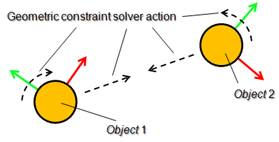
[The geometric constraint solver closure constraint]

/V-REP3/V-REP_PRO_EDU/helpFiles/en/images/gcsOp2.jpg)
[Closing action of the geometric constraint solver (1) intermediate situation, (2) final situation]
GCS会试图将closure pair的位置以及姿态重合,因此机构要有足够的自由度。对于平面机构(如铰链四杆机构)来说使用GCS保持机构闭合就不合适,可以考虑用IK,tip-target来构成闭环。The geometric constraint solver will try to overlap the position and orientation of the two objects while trying to keep the mechanism coherent (i.e. by only adjusting the joints in IK mode in the mechanism to reach that overlap situation). The objects that the geometric constraint solver uses to specify closure constraints are dummies. To this end, two dummies need to be marked as closure pair. This can be adjusted in the dummy properties by selecting the opposite dummy as Linked dummy and specifying GCS, overlap constraint for the Link type. Following figure illustrates two linked dummies specifying a geometric constraint solver closure constraint:
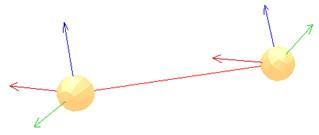
[Two linked dummies specifying a closure constraint]
Specifying the mechanism to be solved
All objects that can be reached from a given object by following a path that can go will be considered as the same mechanism:
- from one object to its parent object.
- from one object to its child objects.
- from one dummy to its linked dummy (however only links of type GCS, overlap constraint)
即按照上面3种方式从运动链(elements)上某一点开始探索,能够到达的节点都属于同一个机构。如果两个运动链没有公共的节点,但是由类型为GCS,overlap constraint的dummy相连,则这两个运动链仍属于同一个机构。Two object trees that don't share any common parent objects (referred hereafter as elements), can also be part of the same mechanism if two linked dummies join them. This is illustrated in following figure:
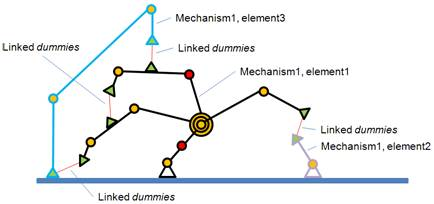
/V-REP3/V-REP_PRO_EDU/helpFiles/en/images/gcsOp4.jpg)
[One mechanism composed by 3 elements (object trees)]
The last parent object of the object that is chosen as the starting point of the mechanism exploration (path exploration) is referred to as the base object of the mechanism. When the geometric constraint solver tries to solve a mechanism, it will try to do so by keeping the base object of the mechanism in place(求解几何约束时选作base的object会固定住不动). This is important to remember. To specify a mechanism to be solved, select an object parented with the base object of the mechanism and in the geometric constraint solver dialog click insert new object. One same mechanism can only be registered once for solving. Mechanisms that do not include at least one joint in IK mode will not be handled by the solver.
Specifying additional constraints
Additional positional constraints can be specified for a mechanism. This can be done with two linked dummies that form a tip-target pair (specify GCS, tip/GCS, target as Link type in the dummy properties). Following figures illustrate two linked dummies, where one is marked as target:
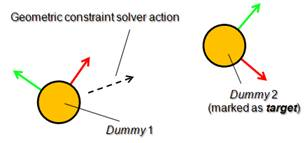
/V-REP3/V-REP_PRO_EDU/helpFiles/en/images/gcsOp5.jpg)
[The geometric constraint solver position constraint]
注意GCS, tip/GCS, target与GCS, overlap constraint的区别是:GCS, target不会被当做机构的一部分,解算时target不动tip移动到与target重合;而GCS, overlap constraint类型的dummy则属于同一个机构,解算时会同时移动直到重合。The dummy marked as target is not considered as part of the mechanism and therefore will not move during geometric constraint resolution, while the other dummy will try to reach the same position as the dummy marked as target.
/V-REP3/V-REP_PRO_EDU/helpFiles/en/images/gcsOp6.jpg)
[Position constraint action of the geometric constraint solver (1) intermediate situation, (2) final situation]
使用GCS(几何约束求解器),可以用鼠标拖动场景中的物体进行直观地控制。During simulation, a mechanism that was previously registered to be solved with the geometric constraint solver can be manipulated in a flexible way with the mouse, when the mechanism navigation mode is selected. That mode can be enabled via following API call: simSetNavigationMode. Simply click and drag any shape object that is part of the mechanism, and the solver will try to take into account that additional position constraint.
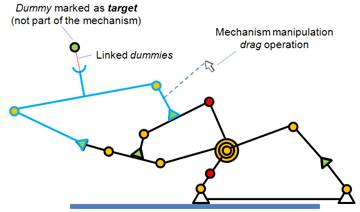
[Mechanism with two additional position constraints]
It is good practice to build your mechanism as a tree structure (i.e. where all objects in the mechanism have at least one common parent object) and have linked dummies be in charge of closing certain tree branches. By doing so you reduce the mechanism's complexity, you simplify the mechanism's scene hierarchy representation, and you will be able to handle the mechanism as a model.
下面是一个简单的例子,用鼠标选中门并按住左键拖动,可以看到门能跟着鼠标运动。修改Model browser/Models/infrastructure/doors/manual door中的场景和代码,添加一个控制球和一组Dummy(类型分别设置为GCS, tip/GCS, target),然后在Calculation Modules的Geometric Constraint Solver选项页中将根节点door设为机构的base 。最后将旋转关节设为Inverse kinematics模式,进行仿真:
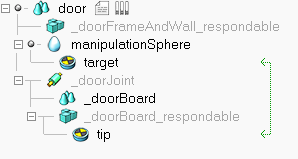
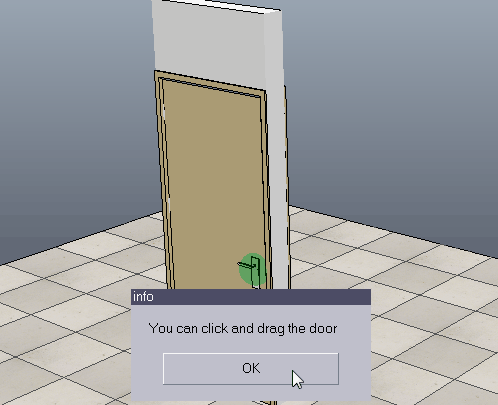
代码如下:
if (sim_call_type==sim_childscriptcall_initialization) then
jointHandle=simGetObjectHandle('_doorJoint')
sphereHandle=simGetObjectHandle('manipulationSphere')
-- Retrieves the navigation and selection mode for the mouse
initialMode=simGetNavigationMode()
-- Sets the navigation and selection mode for the mouse.
simSetNavigationMode(sim_navigation_objectshift+
sim_navigation_clickselection+
sim_navigation_ctrlselection+
sim_navigation_shiftselection+
sim_navigation_camerazoomwheel+
sim_navigation_camerarotaterightbutton)
tipDummyHandle=simGetObjectHandle('tip')
-- sim_intparam_prox_sensor_select_down: Allows to enable message or callback generation when a shape
-- was clicked (down-click) in the scene. The click is a "geometric" click. This value is set to zero
-- at simulation start and simulation stop.
-- (-1: enabled for all visible shapes in the scene)
simSetInt32Parameter(sim_intparam_prox_sensor_select_down, -)
simDisplayDialog("info","You can click and drag the door",sim_dlgstyle_ok,false)
end
if (sim_call_type==sim_childscriptcall_sensing) then
-- auxiliaryData[1]: objectID
-- auxiliaryData2[1] ~ auxiliaryData2[3]: coordinates of clicked point
local message,data,data2 = simGetSimulatorMessage()
while message>- do -- (-1 if no message is available or in case of an error)
if message == sim_message_prox_sensor_select_down then
-- move manipulation sphere according the position of clicked point
simSetObjectPosition(sphereHandle,-,{data2[],data2[],data2[]})
simSetObjectPosition(tipDummyHandle,-,{data2[],data2[],data2[]})
simSetObjectParent(tipDummyHandle, data[], true)
-- select the manipulation sphere to move
simRemoveObjectFromSelection(sim_handle_all)
simAddObjectToSelection(sim_handle_single,sphereHandle)
end
message,data,data2 = simGetSimulatorMessage()
end
end
if (sim_call_type==sim_childscriptcall_cleanup) then
simRemoveObjectFromSelection(sim_handle_all) -- removes all objects from the selection
simSetInt32Parameter(sim_intparam_prox_sensor_select_down, ) -- 0: disabled
simSetNavigationMode(initialMode)
end
下面是一个修改自V-REP_PRO_EDU\scenes\constraintSolverExample.ttt的例子,用鼠标选中机构上任意杆件进行拖拽,可以看到机构能跟着一起运动而不散开:
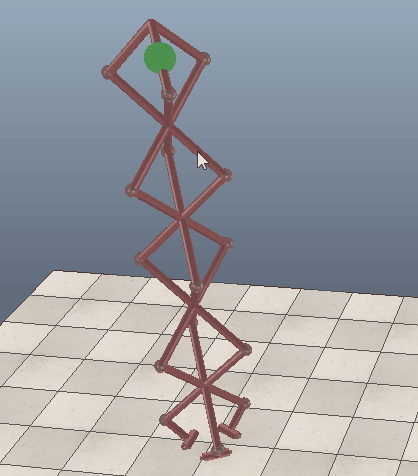
Geometric constraint solver operation
When building a mechanism that will be solved by the geometric constraint solver, make sure that the mechanism is coherent and that constraints are not impossible (i.e. that there are enough degrees of freedom for the mechanism to work). Following figures show an example of a mechanism and its resolution:

[(1) Mechanism containing 3 elements before and (2) during simulation]

[Same mechanism, but different base object (1) before and (2) during simulation]

[(1) Mechanism containing 2 elements before and (2) during simulation]
参考:
Using the geometric constraint solver
Solving IK and FK for any type of mechanism
control the model using mouse in simulation mode
V-rep学习笔记:Geometric Constraint Solver(几何约束求解)的更多相关文章
- V-rep学习笔记:并联机构正逆运动学
Solving the FK problem of simple kinematic chains is trivial (just apply the desired joint values to ...
- <老友记>学习笔记
这是六个人的故事,从不服输而又有强烈控制欲的monica,未经世事的千金大小姐rachel,正直又专情的ross,幽默风趣的chandle,古怪迷人的phoebe,花心天真的joey——六个好友之间的 ...
- MySQL学习笔记一
MySQL 学习笔记 一 一.数据库简单介绍 1. 按照数据库的发展时间顺序,主要出现了以下类型数据库系统: Ø 网状型数据库 Ø 层次型数据库 Ø 关系型数据库 Ø 面向对象数据库 上面4中数据库系 ...
- 菜鸟的MySQL学习笔记(一)
本学习笔记是照搬慕课网<与MySQL的零距离接触>内容,特此感谢! 1-1 mysql的安装与配置 Windows环境下的MSI安装: 1.安装: 双击MSI文件->用户协议-> ...
- OGG学习笔记02-单向复制配置实例
OGG学习笔记02-单向复制配置实例 实验环境: 源端:192.168.1.30,Oracle 10.2.0.5 单实例 目标端:192.168.1.31,Oracle 10.2.0.5 单实例 1. ...
- Hibernate 马士兵 学习笔记 (转)
目录(?)[+] 第2课 Hibernate UML图 第3课 风格 第4课 资源 第5课 环境准备 第6课 第一个示例Hibernate HelloWorld 第7课 建立Annotation版本的 ...
- R语言与机器学习学习笔记
人工神经网络(ANN),简称神经网络,是一种模仿生物神经网络的结构和功能的数学模型或计算模型.神经网络由大量的人工神经元联结进行计算.大多数情况下人工神经网络能在外界信息的基础上改变内部结构,是一种自 ...
- 蒟蒻的长链剖分学习笔记(例题:HOTEL加强版、重建计划)
长链剖分学习笔记 说到树的链剖,大多数人都会首先想到重链剖分.的确,目前重链剖分在OI中有更加多样化的应用,但它大多时候是替代不了长链剖分的. 重链剖分是把size最大的儿子当成重儿子,顾名思义长链剖 ...
- Oracle基础学习笔记
Oracle基础学习笔记 最近找到一份实习工作,有点头疼的是,有阶段性考核,这...,实际想想看,大学期间只学过数据库原理,并没有针对某一数据库管理系统而系统的学习,这正好是一个机会,于是乎用了三天时 ...
随机推荐
- Easyui numberbox获取焦点事件
Html文件: <input id="auctionBrandNoGetByHand" style="width:160px;" class=" ...
- go语言之进阶篇方法表达式
1.方法表达式 示例: package main import "fmt" type Person struct { name string //名字 sex byte //性别, ...
- MySQL 高可用性—keepalived+mysql双主(有详细步骤和全部配置项解释)
博主QQ:819594300 博客地址:http://zpf666.blog.51cto.com/ 有什么疑问的朋友可以联系博主,博主会帮你们解答,谢谢支持! 前言:生产环境中一台mysql主机存在单 ...
- Spring Boot Maven Plugin打包异常及三种解决方法:Unable to find main class
[背景]spring-boot项目,打包成可执行jar,项目内有两个带有main方法的类并且都使用了@SpringBootApplication注解(或者另一种情形:你有两个main方法并且所在类都没 ...
- Python3 简单验证码识别思路及实例
1.介绍 在爬虫中经常会遇到验证码识别的问题,现在的验证码大多分计算验证码.滑块验证码.识图验证码.语音验证码等四种.本文就是识图验证码,识别的是简单的验证码,要想让识别率更高, 识别的更加准确就需要 ...
- python用post访问restful服务接口
具体代码如下: import requests import json data={"]} url="http://XXXXX" data_json = json.dum ...
- getWidth() 和 getMeasuredWidth()的区别
getWidth(): View在设定好布局后整个View的宽度. getMeasuredWidth(): 对View上的内容进行测量后得到的View内容占据的宽度,前提是你必须在父布局的onLa ...
- linux运维需要掌握的基础知识
踏入linux运维工程师这一职业,其实有很多工具技能需要掌握,下面我来给大家一一介绍. 1.shell脚本和另一个脚本语言,shell是运维人员必须具备的,不懂这个连入职都不行,至少也要写出一些系统管 ...
- Syntax error missing ; before *
[问题] I have a header file like so: #pragma once #include "gamestate.h" #include "Ex ...
- servlet种下cookie后如何携带cookie继续往下走
事情是这样的,今天我在应用1里面手动种下了一个cookie,然后它会发接着访问应用2,因为是我手动setCookie,所以它还没来得及携带cookie继续前往下一站,于是,apple pen,炸了. ...
